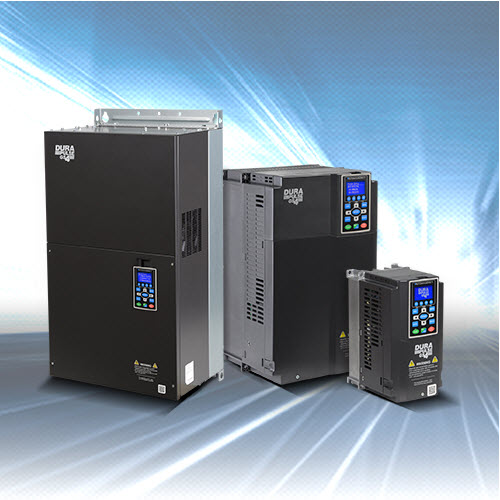Today, energy conservation and cost-cutting solutions have become a major focus in the manufacturing sector. Energy costs continue to increase and the extreme growth in China is contributing to rising costs in other areas of goods, including steel and coal. Managers of manufacturing facilities are faced with many questions regarding energy conservation and efficiency. They are evaluating what is viable for their facility. Periodic reviews of soaring costs are necessary to stay competitive as the implementation of new processes can be expensive. That’s where today’s more energy efficient AC drives can help.
Historically, manufacturers of drives have been able to differentiate their product offerings from those of their fellow competitors on a combination of price, performance, quality, and service. As the market has matured, drive prices have continued to decrease, the performance gap has narrowed, and the level of quality has increased. AC drives have almost become commodities; however, there are still areas where drive manufacturers can add value for their customers and differentiate their products from their competitors. In addition to energy efficiency and cost, other notable areas are power quality, ease of use, size, and integrated functionality.

AC drives, sometimes called variable frequency drives, are primarily installed for either improvement in energy efficiency or for better control of industrial processes. In each type of installation, users must decide which manufacturer’s model offers the desired mix of characteristics for cost, performance, precision, environmental impact, ease of use, communications, interface, installation, and size.
Typical industrial applications for AC drives include extruders, centrifuges, presses, pumps, conveyors, material handling, and cranes. The AC drive’s ability to reliably control speed and/or torque is critical. Not only must the drive provide precise control of its load, it must also operate for extended periods of time, with many applications requiring 24-hour operation. The primary evaluation criteria for AC drives in industrial applications have typically centered on reliability and performance. Initial cost is usually a secondary consideration, limited to the AC drives that have met the initial performance requirements.
Energy Savings
As energy costs continue to rise, the savings from the use of drives become even more significant. Electric motors consume approximately half of all the electricity used in the United States. Motors controlled by AC drives are among the most efficient of all types of motors in use. Therefore, widespread use of AC drives in industrial, HVAC and similar applications can help reduce current levels of energy consumption.
In applications designed with energy efficiency in mind, AC drives are used to control the speed of devices such as blowers, fans, pumps, and chillers. The primary objective in many of these applications is the reduction of energy usage, measured over a pre-defined period of payback. Typical payback periods as short as 18 months or even one year are used to justify the purchase of an AC drive system. In some cases, the energy cost savings can pay for the AC drive and installation in even less time. Of course, payback periods and the amount of savings will vary with the application. Typically, all motors must be sized for the worst case scenario, often the starting of the device. Once running, the motor no longer requires the same amount of current to keep running, but without an AC drive in the system, most motors will continue to draw unnecessarily high current levels. With an AC drive operating the motor, the drive adjusts the current levels automatically to meet the demands of the application. Additional savings are also possible during lower demand cycles, as the motor speed can be reduced, which in turn reduces the energy used during those periods.
One promising mainstream application in this category is the use of sub-micro drives on residential HVAC units. As the cost of drives continues to fall and the potential energy savings continue to increase, this application should become more common. The compressor pump motor and the condenser fan motor on a residential air conditioner each require high start-up current. Once up to speed, the efficiency of both motors can be improved if they are controlled by drives. Under drive control, these motors can also operate very efficiently at slower speeds on certain days, based on the temperature differential between the indoor and outdoor environments.
Though the immediate and primary impact of applying an AC drive is the reduction in energy costs, the introduction of the AC drive into the installation must not affect reliability. For this reason, redundant systems, as well as bypass options and mechanical flow control, are often installed.
Power Quality
There are many compelling reasons to implement AC drives. However, due to their consumption of non-sinusoidal currents, power quality problems can arise. Without proper protection and power input considerations, the installation of AC drives can cause power quality and interference problems that may affect nearby electrical equipment.
Most of today’s AC drives use diode-rectifier circuits on the power input side (front end) of the drives. When these drives are installed without line reactors, EMF filters, and RF filters on their power inputs, they can negatively impact the power quality of an entire factory or facility. The Insulated Gate Bipolar Transistors (IGBTs) that are already used extensively on the motor control side (back end) of most AC drives are now being used to replace the diode-rectifiers on the front end of the drive. IGBT-based rectifiers offer several advantages. Lower order current harmonics can be eliminated while maintaining a near-unity displacement power factor across the entire load/speed range. These drives will not require the extensive filtering of the more common diode-rectified drives, and “power factor” is crucial to cost savings for large electrical users. A side benefit of IGBTs on the input side of the drive is a highly reliable ‘soft-start’ function, with no contactors or resistors to fail. Another benefit of IGBT-based rectifiers is their ability to regenerate electrical energy back into the AC lines during braking operations, saving energy and eliminating the need for dynamic braking transistors and resistors. While the higher costs associated with IGBT front-end drives have limited their widespread use, middle to high horsepower applications that demand regeneration will be the obvious early adopters. As the cost of AC drive technology continues to fall, more manufacturers will begin to offer IGBT front-end drives for smaller horsepower applications.
Ease of Use
Due to increased reliability and lower cost, it is not uncommon today for AC drives to be considered commodities. This concept is strengthened by the fact that only minor differences exist between the various hardware platforms used for AC drives. Thus it becomes increasingly difficult for manufacturers to differentiate their products from their competitors. Offering products that reduce training time is an extremely effective competitive advantage.
This can be accomplished through:
• Keypad designs with increased functionality: – larger display size, a greater number of keys, graphical displays, and user-defined keys.
• Hierarchical parameter structures with advanced/complex functions hidden from the average user.
• More intuitive parameter descriptions and error messages that allow customers to interact with the drive in plain English
Shrinking Cost and Size
AC drives will continue to become smaller and cheaper. Three major factors will be responsible for the continuation of this trend:
• The reliability, performance, and cost of electronic power components continue to improve.
• Successive generations of microprocessors continue to offer higher levels of performance and reduced cost.
• The manufacture of these drives continues to migrate to offshore countries (such as China), which have the capa- bility to produce high quality, complex products at substantially lower costs.
Integrated Functionality
In addition to connecting to the AC power system and the motor, an AC drive must also interface with external devices, such as PLCs, limit switches, push buttons, potentiometers, etc. In order to connect to these auxiliary devices, an AC drive typically provides a number of both digital and analog I/O connections. Because of the flexibility inherent in the microprocessor-based design, these inputs and outputs can usually be configured to perform many different functions. This flexibility allows an off-the-shelf product to be custom tailored to each individual application. In many instances, the need for specialized function cards is eliminated due to the additional functionality present in the AC drive. The following are areas in which manufacturers will continue to add integrated functionality to their products:
• Manufacturers will continue to add programmable functionality, perhaps even offering the functional equivalent of an embedded PLC.
• With more emphasis placed on ease of use, the user interface will be a primary focus. Manufacturers have already begun replacing simple alphanumeric keypads with “real- language” LCD-based models. Remote mounting of the keypad is also now possible with some models. This trend is expected to continue with additional features, such as graphics, being offered.
• With the adoption of flux vector technology, the line between AC and servo drives continues to blur. Manufacturers will continue to add enhanced motion control algorithms to their AC drives, making the distinction between AC and servo drives even more difficult to define.
In Closing
It seems ironic that the global pressures that have increased the “commoditization” of AC drives now provide an opportunity for manufacturers to create product differentiation. As the global AC drive market matures, downward cost pressures have forced many manufacturers to develop global designs for their AC drive product lines. Manufacturers can leverage these universal hardware platforms and develop differentiated products through firmware/software customization for the different markets of the world. Manufacturers can focus on the unique needs of each market and develop products that incorporate the “ease of use” and integrated functionality that each market requires. What more could a customer want: an AC drive that possesses the characteristics of high quality and low cost derived from a global platform coupled with a feature set specific to his needs.
To read more articles about variable speed drives, click here.
Originally Published: March 1, 2005


